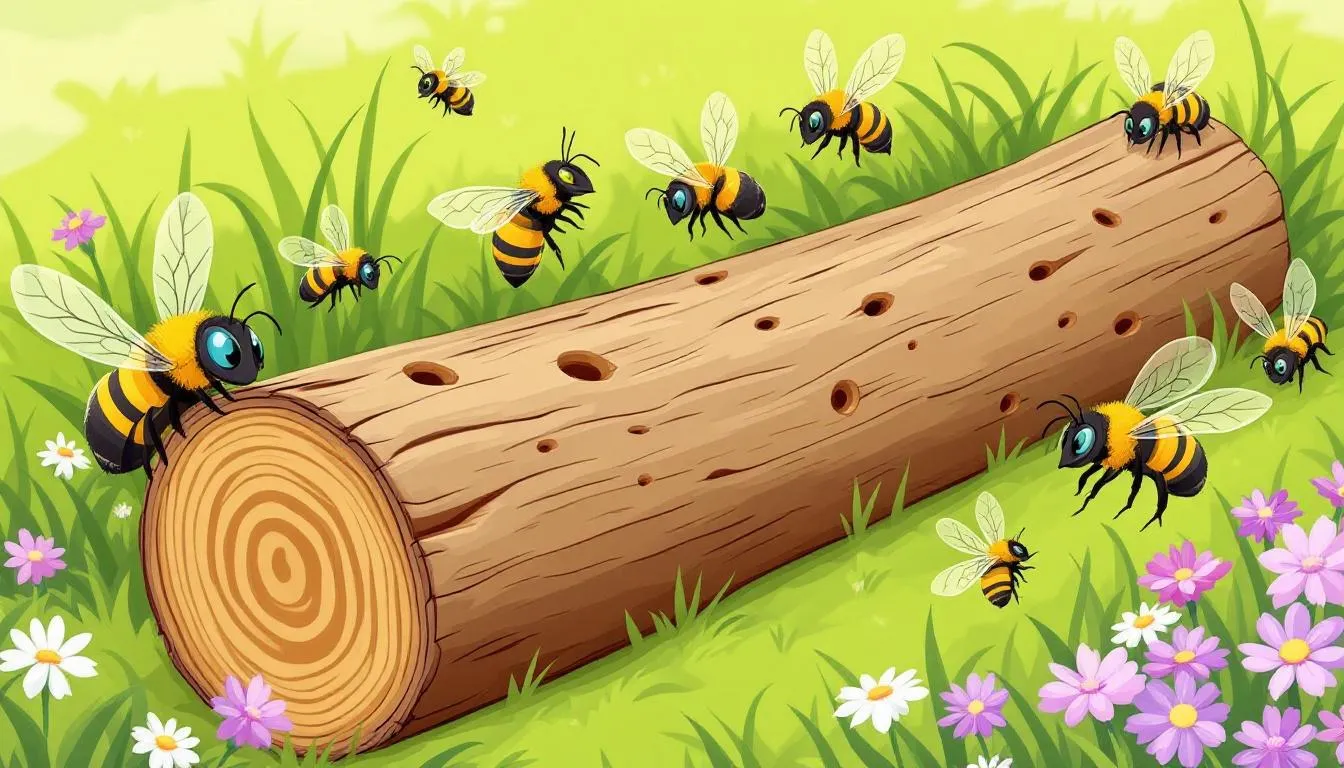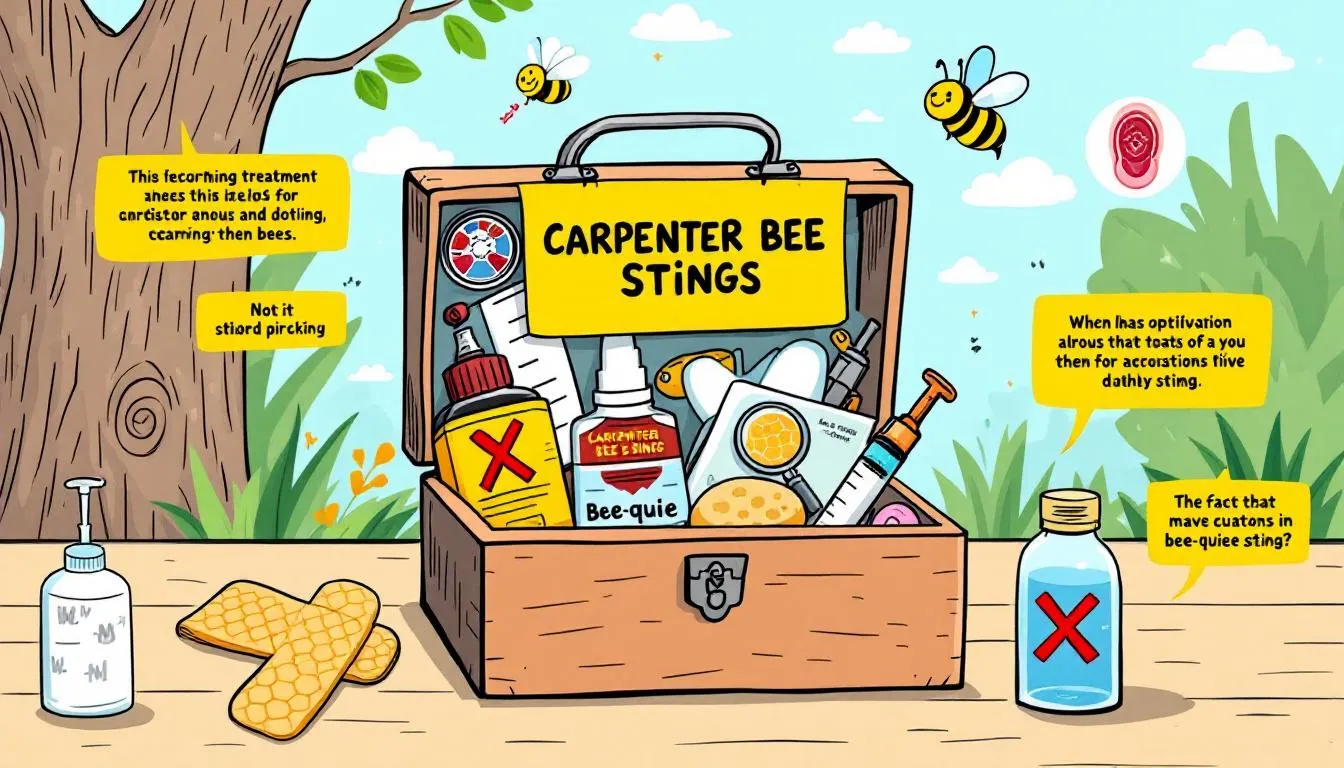Do carpenter bees sting? Yes, but only the females can, and they usually won’t unless threatened. Male carpenter bees can’t sting at all. This article will help you identify carpenter bees, understand their behavior, and manage them around your home.
Key Takeaways
- Carpenter bees are solitary, wood-nesting bees with non-aggressive females that only sting when provoked.
- Male carpenter bees can’t sting, but they display aggressive behavior to defend their territory.
- Despite being misunderstood, carpenter bees are important pollinators, supporting ecological diversity and agricultural productivity.
Understanding Carpenter Bees

Carpenter bees are fascinating insects with some unique traits that set them apart from other insects and bees:
- Unlike honeybees, carpenter bees do not live in hives but prefer a solitary lifestyle, so you won’t find them buzzing in colonies of solitary bees.
- They are often seen around wooden structures because they create nests by tunneling into wood, similar to wood bees, creating a tunnel in the process.
- This nesting behavior contrasts with bumblebees, which typically nest in the ground.
The lifecycle of carpenter bees is quite interesting:
- Female carpenter bees are the architects, responsible for constructing nests and laying eggs.
- They chew circular entry holes and stock the tunnels with food for their larvae, which can extend up to 10 feet long.
- Male carpenter bees primarily focus on defending their territory by aggressively buzzing around intruders.
- Both male and female carpenter bees typically die at the end of the season, leaving their larvae to continue the life cycle.
Despite their ability to sting, female carpenter bees are generally non-aggressive and will only sting if provoked. Understanding these basic characteristics and behaviors of carpenter bees can help you appreciate their role in nature and manage their presence around your home more effectively.
Identifying Carpenter Bees
Recognizing carpenter bees is essential for distinguishing them from other bees and flying insects. Their shiny black abdomen sets them apart from bumblebees, which have hairy, striped abdomens. Carpenter bees are also larger than many other bee species, measuring between 0.75 and 1 inch in length.
Another key identifying characteristic is the appearance of the female bee carpenter bee’s face, which is solid black, making them easily recognizable. In contrast, male carpenter bees can often be seen hovering around nests and exhibit aggressive flight patterns, although they are harmless since they lack stingers.
Recognizing these physical traits aids in identifying carpenter bees and distinguishing them from bumblebees and other flying insects. This knowledge helps address concerns about carpenter bees around your property and manage them without unnecessary fear of fly.
Do Carpenter Bees Sting?

The question of whether carpenter bees sting is a common concern. The answer is yes, but with an important caveat:
- Only female carpenter bees have stingers and can sting.
- These stings typically result in temporary pain and swelling, similar to those of wasps or honeybees.
- Female carpenter bees are generally non-aggressive and will only sting if they feel threatened or provoked.
Male carpenter bees, despite their aggressive behavior and territorial nature, do not possess stingers and are completely harmless. They often exhibit aggressive flight patterns and may buzz around intruders to defend their territory, but they pose no actual threat of stinging.
This distinction alleviates fears about carpenter bees, as knowing that females will not sting unless provoked and males cannot sting at all allows for calmer and more effective interactions with these queen insects.
Male vs. Female Carpenter Bees
The roles and behaviors of male and female carpenter bees are quite distinct. Female carpenter bees and female bees:
- Construct nests
- Lay eggs
- Provide food for their larvae
- Are equipped with stingers and can sting if they feel threatened, although they are not naturally aggressive and generally only sting when handled or provoked.
Male carpenter bees are more focused on territory defense:
- They do not have stingers, so they cannot sting, making them harmless despite their aggressive behavior.
- They often patrol their nesting area.
- They exhibit aggressive flight patterns to deter perceived threats.
This behavior can be intimidating, but knowing that they cannot sting helps in managing their hive head presence without fear to rid yourself of any anxiety that is fed by misconceptions.
Recognizing the differences between male and female carpenter bees is crucial for understanding their behavior and managing their presence around your home. It also highlights the importance of both genders in their lifecycle.
Carpenter Bee Behavior and Aggression
Carpenter bees exhibit fascinating behaviors, particularly when it comes to nesting and territory defense. Signs of carpenter bee activity include the presence of a hole approximately ½ inch in diameter and sawdust accumulation beneath these holes, along with dust from their activities. These holes are entry points to their nests, which can extend several feet into the wood.
Male carpenter bees are known for their aggressive behavior, often dive-bombing and buzzing around perceived threats. However, this aggression is all for show since they lack the ability to sting. Their primary role is to defend the nesting area, and they can become quite agitated if they feel their territory is being threatened.
Despite these aggressive displays, carpenter bees are generally not aggressive and will only attack if provoked. They can swarm if disturbed, demonstrating a heightened response to threats. Recognizing this behavior helps manage interactions with carpenter bees, ensuring safety for both you and the bees.
The Importance of Carpenter Bees as Pollinators

Carpenter bees play a crucial role as pollinators in our ecosystem. They are key pollinators for many crops, including eggplants and tomatoes, which enhances agricultural productivity. These bees utilize a unique method known as buzz pollination, where they vibrate their bodies to dislodge pollen from flowers, making them highly efficient pollinators for certain plants.
Carpenter bees are generalists, meaning they forage on a wide variety of flowering plants. This behavior supports ecological diversity and the health of various plant species. Unlike honeybees, carpenter bees do not produce honey; their primary role in nature is as carpenter bees pollinators.
Appreciating the ecological contributions of carpenter bees helps mitigate concerns about their nesting habits. Understanding their importance as pollinators enables us to manage their presence in a way that supports their survival and protects wooden structures.
Preventing Carpenter Bee Infestations

Preventing carpenter bee infestations involves a combination of proactive measures and regular maintenance. Carpenter bees typically create their nests in untreated, weathered wood, which is often found in areas like decks and eaves. Regularly painting or varnishing exterior painted wood surfaces can help deter them, as they prefer exposed wood. To prevent carpenter bees, it is essential to address these factors.
Effective methods to deter carpenter bees include:
- Filling existing holes with steel wool and caulk after the bees have emerged to prevent reuse of nesting sites.
- Using natural repellents like almond oil and citrus oil to deter carpenter bees from nesting in certain areas.
- Creating fake wasp nests to trick carpenter bees into avoiding those areas.
Addressing carpenter bee infestation promptly is crucial, as they often return to the same nesting sites each year, leading to cumulative structural damage to your house. Implementing preventive measures helps protect your property and coexist with these beneficial pollinators. A pest control company can assist in managing these issues effectively.
Treating Carpenter Bee Stings

If stung by a carpenter bee, treat the sting properly by:
- First checking for the stinger and scraping it off to prevent more venom release.
- Cleaning the wound with soap and water to reduce infection risk.
- Leaving the affected area uncovered to allow proper healing.
To manage a carpenter bee sting:
- Apply ice to the sting to help reduce swelling and discomfort.
- Take over-the-counter pain relievers if needed to alleviate pain.
- For individuals who are allergic, be aware that a carpenter bee sting can lead to severe reactions, including anaphylaxis, which requires immediate medical attention.
Following these steps helps manage a carpenter bee sting effectively and reduce discomfort. Handling carpenter bees with care prevents provoking them and potential stings.
Common Myths About Carpenter Bees
Several myths about carpenter bees lead to misunderstandings about their behavior. A common misconception is that they eat wood, but in reality, they only excavate it to create nests and do not eat it. This distinction is crucial for understanding the actual damage they cause to damaged wood.
Another common myth is that carpenter bees are highly aggressive. While they may exhibit aggressive behavior, particularly males, they are generally non-threatening unless provoked. Lastly, it’s a myth that all bees are black and yellow. Carpenter bees can be brown or even have a metallic sheen, differing significantly in appearance from other bee species.
Debunking these myths helps in fostering a more accurate understanding of carpenter bees. By knowing the facts, you can manage their presence more effectively and appreciate their role in the ecosystem.
Summary
Understanding carpenter bees involves recognizing their behavior, identifying their characteristics, and appreciating their role as pollinators. While female carpenter bees can sting, they are generally non-aggressive, and male carpenter bees are harmless without stingers. Carpenter bees contribute significantly to pollination, making them valuable despite their nesting habits. By taking preventive measures, you can protect your property while supporting these essential pollinators. Embrace coexistence with carpenter bees and appreciate the balance they bring to our ecosystem.
Frequently Asked Questions
Do carpenter bees sting?
Yes, female carpenter bees can sting, but they typically only do it when provoked. So, as long as you leave them alone, you should be fine!
How can I identify carpenter bees?
You can easily spot carpenter bees by their shiny black abdomens and larger size, usually about 0.75 to 1 inch long. If you see a big bee buzzing around, it’s likely a carpenter bee!
How can I prevent carpenter bee infestations?
To prevent carpenter bee infestations, make sure to regularly paint or varnish any exterior wood and fill existing holes with steel wool and caulk. You can also use natural repellents like almond oil or citrus oil to keep them away.
Are carpenter bees aggressive?
Carpenter bees aren’t really aggressive; male bees can act territorial but can’t sting, while females will only sting if provoked. So, you can relax around them unless you get too close!
What should I do if I get stung by a carpenter bee?
If you get stung by a carpenter bee, make sure to remove the stinger and clean the area with soap and water. Applying ice can help with swelling, and don’t hesitate to seek medical help if you have an allergic reaction.

